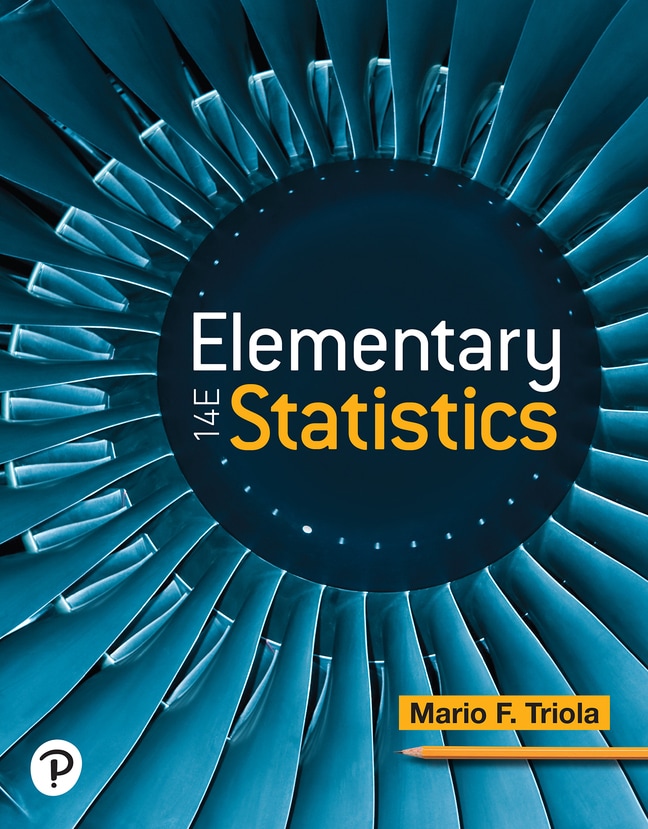
Elementary Statistics, 14th edition
- Mario F. Triola

- Watch and learn
Videos & animations bring concepts to life
- Listen on the go
Learn how you like with full eTextbook audio
- Find it fast
Quickly navigate your eTextbook with search
- Stay organized
Access all your eTextbooks in one place
- Easily continue access
Keep learning with auto-renew
In Elementary Statistics, real data brings statistics to life. From cybersecurity to drones and more, statistics shapes the world around us. Acclaimed author Marty Triola offers current applications and abundant new real data to help students of all majors understand the role of statistics in our lives. Updates in the 14th Edition keep this text more relevant and supportive than ever, with a wealth of new data sets, exercises and examples along with larger data sets, content updates and new videos.
Published by Pearson (July 14th 2021) - Copyright © 2022
ISBN-13: 9780137366446
Subject: Introductory Statistics
Category:
1. Introduction to Statistics
- 1.1 Statistical and Critical Thinking
- 1.2 Types of Data
- 1.3 Collecting Sample Data
- 1.4 Ethics in Statistics (download only)
2. Exploring Data with Tables and Graphs
- 2.1 Frequency Distributions for Organizing and Summarizing Data
- 2.2 Histograms
- 2.3 Graphs That Enlighten and Graphs That Deceive
- 2.4 Scatterplots, Correlation, and Regression
3. Describing, Exploring, and Comparing Data
- 3.1 Measures of Center
- 3.2 Measures of Variation
- 3.3 Measures of Relative Standing and Boxplots
4. Probability
- 4.1 Basic Concepts of Probability
- 4.2 Addition Rule and Multiplication Rule
- 4.3 Complements, Conditional Probability, and Bayes' Theorem
- 4.4 Counting
- 4.5 Simulations for Hypothesis Tests
5. Discrete Probability Distributions
- 5.1 Probability Distributions
- 5.2 Binomial Probability Distributions
- 5.3 Poisson Probability Distributions
6. Normal Probability Distributions
- 6.1 The Standard Normal Distribution
- 6.2 Real Applications of Normal Distributions
- 6.3 Sampling Distributions and Estimators
- 6.4 The Central Limit Theorem
- 6.5 Assessing Normality
- 6.6 Normal as Approximation to Binomial (download only)
7. Estimating Parameters and Determining Sample Sizes
- 7.1 Estimating a Population Proportion
- 7.2 Estimating a Population Mean
- 7.3 Estimating a Population Standard Deviation or Variance
- 7.4 Bootstrapping: Using Technology for Estimates
8. Hypothesis Testing
- 8.1 Basics of Hypothesis Testing
- 8.2 Testing a Claim About a Proportion
- 8.3 Testing a Claim About a Mean
- 8.4 Testing a Claim About a Standard Deviation or Variance
- 8.5 Resampling: Using Technology for Hypothesis Testing
9. Inferences from Two Samples
- 9.1 Two Proportions
- 9.2 Two Means: Independent Samples
- 9.3 Matched Pairs
- 9.4 Two Variances or Standard Deviations
- 9.5 Resampling: Using Technology for Inferences
10. Correlation and Regression
- 10.1 Correlation
- 10.2 Regression
- 10.3 Prediction Intervals and Variation 10.4 Multiple Regression
- 10.5 Nonlinear Regression
11. Goodness-of-Fit and Contingency Tables
- 11.1 Goodness-of-Fit
- 11.2 Contingency Tables
12. Analysis of Variance
- 12.1 One-Way ANOVA
- 12.2 Two-Way ANOVA
13. Nonparametric Tests
- 13.1 Basics of Nonparametric Tests
- 13.2 Sign Test
- 13.3 Wilcoxon Signed Ranks Test for Matched Pairs
- 13.4 Wilcoxon Rank-Sum Test for Two Independent Samples
- 13.5 Kruskal-Wallis Test for Three or More Samples
- 13.6 Rank Correlation
- 13.7 Runs Test for Randomness
14. Statistics Process Control
- 14.1 Control Charts for Variation and Mean
- 14.2 Control Charts for Attributes
15. Holistic Statistics
APPENDICES
- A. Tables
- B. Data Sets
- C. Websites and Bibliography of Books
- D. Answers to Odd-Numbered Section Exercises (and all Quick Quizzes, Review Exercises, and Cumulative Review Exercises)